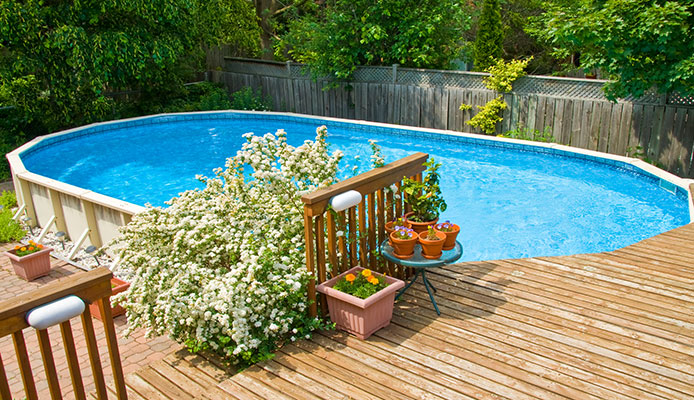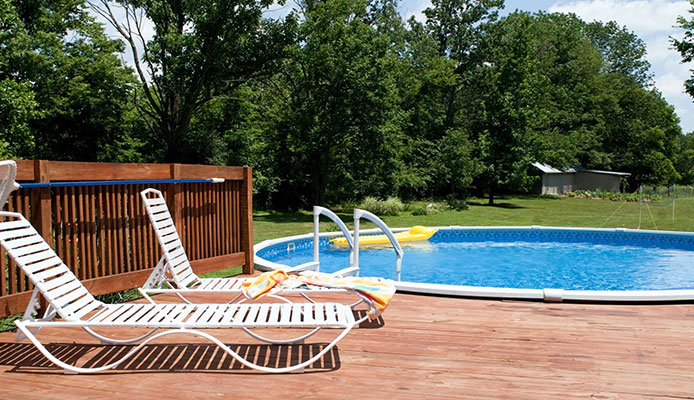
“What should I put under my above ground pool?” That’s one of the important questions that pool owners who are installing an above ground pool on their grass lawns ask. Professional pool installers advise against putting an above ground pool directly on top of grass. So, what to put under the above ground pool on grass? Below we’ll take a look at some of the options available, as well as a discussion as to why building your above-ground pool on grass isn’t such a good idea.
What to Put under Above Ground Pool on Grass
There are several options for you to choose from when deciding what kind of base to put under your above ground pool. Each of these has its advantages and disadvantages, and you’ll want to familiarize yourself with them before putting any money down for construction or purchase.
1. Concrete Pads
When homeowners ask, “What should I put under my above ground pool?” most pool installers would readily answer, “Concrete pads.” There are several reasons why this is so.
Advantages of Concrete Pads
For one, concrete is a solid and reliable material for almost any type of construction. Using a concrete pad ensures that your pool will remain in place ad not shift around.
Second, concrete is tough and the best pad against nutgrass. This nutgrass (or nutsedge as it is also called) is very persistent and forms an upward needle-like point during its growth stages. Because they are strong enough to grow through the asphalt, it would be very easy for them to pierce through above ground pool liners. However, these shouldn’t be a problem if you have a concrete pad in place.
Finally, concrete makes a good pad for above-ground pools on grass because is flat and level. Once mixed, concrete starts as a liquid before it matures and becomes hard. This is basically why it’s so easy to flatten and level it.
For these reasons, a concrete pad is one to be considered when deciding what to put under the above ground pool on the grass. Regardless, there are other factors you need to be aware of before you put any money down for a concrete pad.
Disadvantages of Concrete Pads
First, you don’t have to get your concrete pad smoothed out. Yes, you need it to be flat and level, but completely smoothing it out is not necessary. This is because you still need to put another type of padding on top of your concrete pad.
When concrete matures and becomes hard, the surface is often pretty rough, and letting your above ground pool sit on the surface for a long time will eventually damage the pool liner.
Besides, concrete pads can be rather expensive. This is the main reason why some people choose not to use concrete bases. Aside from the price of concrete which varies from one place to another, you’ll also need to pay contractors and laborers for the concrete work. So if you’re planning to use concrete pads for your above ground pools, be sure to factor these things in your overall above ground pool cost and budget.
2. Commercial Pads
As mentioned earlier, even if you have a concrete base constructed you still need to put another layer of padding over it before installing your above-ground pool. Commercial pads are one of the best options for this purpose. Commercial pads come with a host of features and benefits.
Advantages of Commercial Pads
First, commercial pads are available in pre-cut sizes and most would readily accept standard sized Intex or Bestway above ground pools (or whatever brand of above ground pool you may have). This way, you don’t have to worry about cutting them to make them fit your pool size. Just make sure that you buy the appropriate size for your above ground pool.
Second, although they are available in pre-cut sizes, you still have the option to cut them for a precise fit. You’ll want to make sure that you do this right though, or at least get a professional to do it for you.
Third, commercial pads are made from breathable materials. This allows moisture to escape instead of trapping them underneath the pool.
Lastly, high-quality commercial pads are tough. They are manufactured and designed to be impervious to insects and pests.
Disadvantages of Commercial Pads
There is only one known disadvantage of using commercial pads. That is, they can be pretty expensive. Add that to the cost of having a concrete base constructed and you may find yourself spending more than what you originally planned.
3. Solid Foam Pad
If you’re asking yourself, “What should I put under my above ground pool?” but don’t want to have a concrete pad constructed, then solid foam would be the answer. Solid foam pads can sit directly on top of the grass, but also works well when placed on top of a concrete base without sliding. The foams are made up of polystyrene or polyurethane material and offer a host of benefits.
Advantages of Solid Foam
Just like commercial pads, one advantage of solid foam is that it is very easy to cut and shape. This way you can be sure that your padding is cut-to-fit and you don’t have to worry about any overlaps or excess materials. So if you have a non-standard sized Bestway or Intex above ground pool, you can easily cut the foam to fit it.
Another advantage of solid foam is that they are available in a variety of thicknesses so you shouldn’t have trouble finding one that will provide your above ground pool with the best cushioning.
You might also like: How To Level An Above Ground Pool
Disadvantages of Solid Foam
Just like other types of pads mentioned above, the main drawback of solid foam is its price. However, if you have the budget for it, then rest assured that it will be one investment worth making. Also, cutting solid foam to make it fit your pool’s requirement can be a time-consuming activity.
4. Sand
A layer of sand is the traditional type of padding for above ground pools installed on bare-ground. And if you’re wondering “What should I put under my above ground pool?” but can’t afford a concrete base, then you can use the sand as a base and then place a commercial pad on top of it.
Advantages of Sand Pads
Perhaps the most obvious advantage of a sand pad is that it is inexpensive, especially when compared to other types of padding for above ground pools.
Also, if you’re pretty handy with tools and yard work, you should have no trouble clearing and leveling the sand pad. This again will allow you to save money on labor.
Disadvantages of Sand Pads
One disadvantage of sand pads is that they are not suitable to be placed on tops of concrete-like commercial pads and solid foam pads. Sand will tend to slide which can make the pool unstable.
You’ll also have to think about the sand being washed away by water splashing from the pool. There’s also the issue of insects tunneling in the sand pad.
FAQ

Q: Can I Put Above Ground Pool On Grass?
Although it is possible to install an above ground pool on grass lawns, it’s not always recommended to do so. For one, certain grass species like nutgrass can penetrate the above ground pool liner, making it look like you’re growing seaweeds in your pool. The dead grass underneath the above ground pool will also smell terrible once they decay.
Q: Can I Put Above Ground Pool On Artificial Grass?
Yes, you can put above ground pools on artificial grass, but it is not without consequences. For one, the weight of the pool materials and the water will damage and flatten the blades of the artificial grass. Although this can be remedied by brushing up the flattened blades, it won’t be in the same condition as the ones surrounding it.
Q: What Should I Put Under A Pool On Grass?
There are plenty of options for you to choose from when looking for what to put under above ground pool on grass. You can go for concrete pads, commercial pads, sand, or foam with each of them having their own pros and cons. Consider which option would best suit your needs and budget before committing to any of them.
Globo Surf Overview
Homeowners have several options regarding what to put under the above ground pool on grass as listed above. So the next time you ask yourself, “What should I put under my above ground pool” simply go over the article and make your choice. Just be sure that you put considerable thought into your decision so you don’t end up making the wrong choice. Not only will that mistake be costly, but it can also significantly affect how happy you’d be with the result.
Above Ground Pool Guides:
- Pool Deck Cleaning: How To Clean Pool Deck
- How To Heat An Above Ground Pool Fast
- Above Ground Pool Removal: How To Take Down Above Ground Pool
- How To Setup Intex Pool In Less Than 1h
- Intex Pool Cleaning Guide: Intex Pool Chemicals Startup
- How To Drain An Above Ground Pool Very Fast
- DIY Above Ground Pool: Build Above Ground Pool From Scratch
- 5 Easy Steps To Open An Above Ground Pool
- Swimming in The Rain: Is It Safe to Swim in The Rain?
- 8 Ways To Maintain And Clean Your Above Ground Pool
- What Is A Spool Pool?

